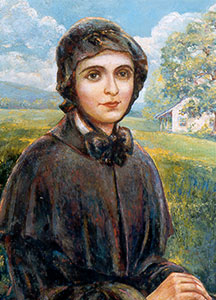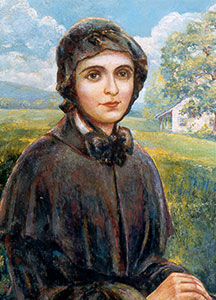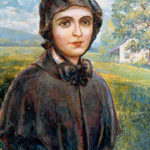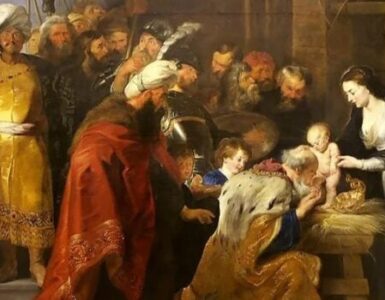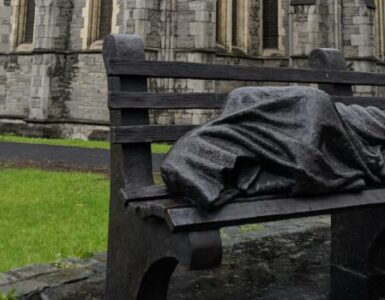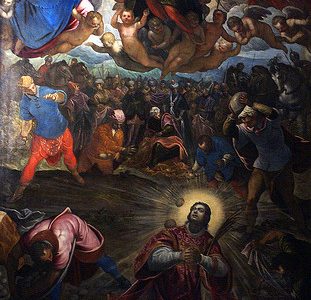St. Elizabeth Ann Seton (1774-1821), whose feast day we celebrate on January 4, is truly a saint for everyone. She was a devoted wife, mother of five children, convert, and religious. The foundress of the Sisters of Charity of St. Joseph–the first congregation of women religious in the United States, Mother Seton also started the first parochial school in the United States, started the first American Catholic orphanage, and was the first native born citizen to be canonized. It was St. Elizabeth’s belief in the Real Presence of Jesus in the Blessed Sacrament which led to her conversion to Catholicism. We need her intercession in these times to help renew our faith in our Eucharistic Lord.
Following her husband’s death, St. Elizabeth and her small children stayed with the Filicchi family in Italy. Although St. Elizabeth was not yet Catholic, she found solace praying in the family’s chapel where the Blessed Sacrament was reserved. In her writings, St. Elizabeth reflected: “How sweet, the presence of Jesus to the longing, harassed soul! It is instant peace, and balm to every wound.” She later came to believe in the true presence of Jesus in the Holy Eucharist and converted, despite rejection from her family and job discrimination in New York City. St. Elizabeth prayed that Jesus might take her heart and “lock it up forever in His little Tabernacle.”
Prior to St. Elizabeth’s entrance into the Catholic Church, Eucharistic processions passed by her home on several occasions. Her longing for the Holy Eucharist was expressed in a letter to a friend: “How happy we would be if we believed what these dear souls believe: that they possess God in the Sacrament. . . . When they carry the Blessed Sacrament under my window. . . . I cannot stop the tears at the thought. My God how happy I would be. . . if I could find you in the church as they do.” She also wrote:
“How many thoughts on the happiness of those who possessed this, the blessed faith of Jesus still on earth with them, and how I should enjoy the heavenly consolation of speaking heart to heart with Him in His tabernacles, and the security of finding Him in His churches.”
St. Elizabeth would often turn her chair when attending the Protestant Church to face the Catholic Church to be closer to Jesus in the Blessed Sacrament. Once, when attending Mass with a Catholic friend, she knelt at the elevation and thought of St. Paul’s words “they discern not the Lord’s body.” Despite the opposition of her family, her yearning for our Eucharistic Lord was so strong that she entered the Catholic Church.
Our Blessed Mother further drew St. Elizabeth to the Church. In 1804, not long after her husband’s death, St. Elizabeth happened to open a prayer book to the Memorare. She was struck by Mary’s motherhood and love for her personally:
“I felt I really had a Mother which you know my foolish heart often lamented to have lost in early days, and at that moment it seemed as if I had found more than her, even in tenderness and pity of a Mother—so I cried myself to sleep on her heart.”
Daily St. Elizabeth prayed in front of an image of Our Lady of Guadalupe which was given to her in 1811 by Matthias O’Conway of Philadelphia, whose daughter, Isabel, was among the first pupils in Mrs. Seton’s school on Paca Street in Baltimore. Her sister Cecilia, the eldest daughter in the family, was the first candidate of the Sisters of Charity of Saint Joseph. During St. Elizabeth’s time, it hung on the wall over the altar in the White House and later it hung for years in the novitiate. (setonshrine.org) In fact, when you visit her Shrine in Emmitsburg, Maryland today you will see the image of Our Lady of Guadalupe. St. Elizabeth often prayed the Memorare and an English translation is even attributed to her.
Another influence on St. Elizabeth’s conversion was the apostolic succession. Since the hierarchy of the Catholic Church is traced back to the apostles, it confirmed St. Elizabeth’s desire to enter. Again, we see the connection to her Eucharistic devotion in phrases from her writings such as: “If the Lord’s body and blood were not there, really present, how could the Apostle have said: ‘He who eats and drinks without recognizing the body eats and drinks a judgment on himself?’
A few of St. Elizabeth’s hardships–including financial (her husband faced bankruptcy shortly before his death), health (including a quarantine and tuberculosis), and family (the early loss of her mother, the death of her two young daughters, and her son’s wayward life)–are recounted in the book Saintly Solutions to Life’s Common Problems: Many saints’ books include stories about her life such as Day-by-Day Coloring Book of Saints Volume 1.
Despite the obstacles that St. Elizabeth had to overcome, she was a selfless mother and champion for children. St. Elizabeth’s example testified to the dignity of each life. She lovingly cared not only for her own children, but also for her husband’s six young siblings for a time as well as for students and orphans, thus becoming known as Mother Seton. Though she would have preferred to live the life of a hermit, God gave her plenty of work to do in her short forty-six years on earth!
Throughout her life St. Elizabeth spent hours in Eucharistic Adoration and, as she grew older, appeared to be in ecstasy before the Blessed Sacrament. Of the Holy Eucharist, St. Elizabeth wrote: “Can there be any comparison to this blessedness? Adored Lord, increase my faith, perfect it, crown it.” “May I ever find in His adorable Sacrament the same ardent wish, the same fervent desire to be for eternity united with Jesus.”
Eucharistic Reflections from St. Elizabeth Ann Seton
“Unite me to yourself, O adorable victim, life-giving heavenly bread, feed me, sanctify me, reign in me, transform me to yourself—live in me, and let me live in you, let me adore you.”
“The heart preparing to receive the Holy Eucharist should be like a crystal vase.”
“That he is there—oh, heavenly theme!—is as entirely true as that bread naturally taken removes my hunger, so this Bread of Angels removes my pain, my cares; warms, cheers, soothes, contents, and renews my whole being. Merciful God, and I do possess You! Kindest, tenderest, dearest friend, every affection of my nature absorbed in You, still is active, nay, perfected in its operations through Your refining love. Hush, my soul, we cannot speak it. Tongues of angels could not express our treasure of peace and contentment in Him.”
“There is a mystery, the greatest of all mysteries—not that my adored Lord is in the Blessed Sacrament of the Altar—His word has said it, and what so simple as to take that word which is truth itself?—but that souls of His own creation, whom He gave His life to save, who are endowed with His choicest gifts in all things else, should remain blind, insensible, and deprived of that light without which every other blessing is unavailing!”
Memorare translated by St. Elizabeth Ann Seton
Remember O most pious Virgin Mary that no one ever had recourse to you, implored your help or sought your mediation without obtaining relief. Confiding then on your goodness and mercy, I cast myself at your sacred feet, and do most humbly supplicate you O Mother of the Eternal Word to adopt me as your child and take upon yourself the care of my eternal Salvation. O let it not be said my dearest Mother that I have perished, where no one ever found but grace and Eternal Salvation.
✠


